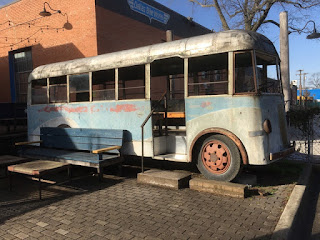On this trip I visited Yamandu Ploskonka, a hand papermaker living in Austin. I became aware of his inventive papermaking when I saw him demonstrating at the 2016 Friends of Dard Hunter meeting in Santa Fe. Originally from Bolivia, Yama made his way TO the USA via the YMCA, and then made his way IN the USA by computer programming. He learned letterpress and printmaking at a young age, was more recently drawn to hand papermaking. He wanted make prints on a quality substrate, and so decided to make the paper himself.
But he did not stop there. He has explored making paper-crete. Even the doors to his studio are made from paper, well actually cardboard, but only cardboard, there is no wood.
Yama is a self taught Rube Goldberg/McGiver/mad scientist who has designed and constructed ingenious bits of equipment to aid in his papermaking. The day I visited he was putting finishing touches on a CMC machine he was building from salvaged parts. I was overwhelmed by his inventiveness: even when reinventing the wheel, he found new creative ways to do it.
Among other things, he has constructed a loom for weaving laid wire using a modified bicycle to twist the wire. And then he used his CMC and laser printers to make the mould that wire was mounted to.
He has modified a washing machine to digest sheet pulp.
This digester also pumps the liquid pulp into a pulper he devised from a garbage disposal and a trashcan.
Then a series of pipes and buckets, modeled after a toilet tank assembly, feeds the pulp into the vat at regulated intervals, keeping the vat’s water to pulp ratio constant.
Then to complete the process, since his moulds do not have backing so cannot easily be couched, he invented an alternate way to get the sheet off the mould. After dipping the mould he sets it on a platform to the left of the vat, with the wet sheet facing up. He then places a pellon on top of the wet sheet, flips over a vacuum box on top of the pellon, and turns it on. That sucks the out the water out of the sheet and draws iff off the mould and onto the pellon. He then places the pellons with paper in a stack to go into a hydraulic press, and then to the stack dryer.
As you can tell. I was impressed. Visit him on Facebook or as Papel Texano.








































